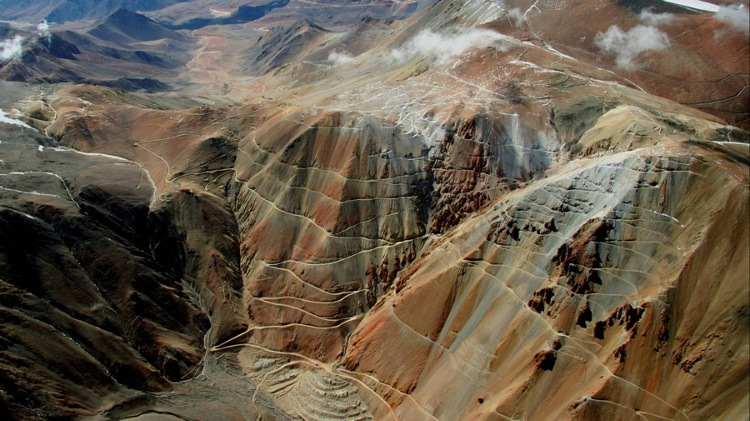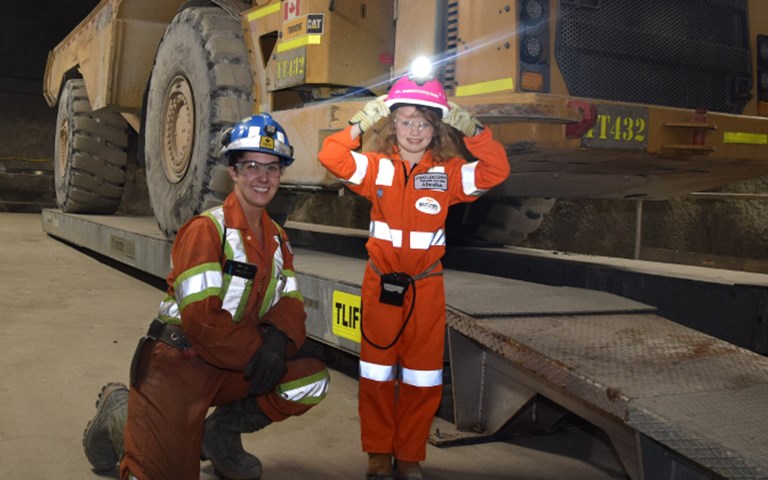Aliesha with a Goldcorp employee underground at Hoyle Pond. Courtesy of Goldcorp
Welcome back to your weekly mining news recap. At the end of the week we’ll catch you up on the mining news from CIM Magazine and elsewhere you may have missed. Now that Halloween has passed and you’re full of candy, here are this week’s headlines: Ontario gets its first new gold mine in a decade, Goldcorp makes an eight-year-old girl’s dreams come true, and even more Q3 results.
******
Quarterly report season is in full swing, so here are this week’s Q3 highlights: First Quantum Minerals is proceeding with construction on its Cobre Panama project despite legal uncertainties; a 51 per cent increase in production has allowed McEwen Mining to invest heavily in exploration efforts on its properties; and Hudbay Minerals has purchased Nevada-focused junior miner Mason Resources in the middle of its spat with shareholder Waterton Global Resource Management.
Harte Gold celebrated the grand opening of its new Sugar Zone gold mine in northern Ontario, which is the first new operating gold mine in the province for the past 10 years. The mine is expected to produce 540 tonnes per day, with the eventual goal of reaching production levels of 1,400 tonnes per day. The ceremony commemorating the mine’s opening was attended by Ontario premier Doug Ford and energy, northern development and mines minister Greg Rickford who referred to Sugar Zone as “a powerful economic engine in the region.”
Goldcorp will receive $5 million from Natural Resources Canada to turn its Borden mine near Chapleau, Ontario, into the “mine of the future.” Goldcorp will replace all the diesel-powered machinery required for the Borden mine with battery-powered electric vehicles. The funding comes from Natural Resources Canada’s Clean Growth program – a $155-million fund that invests in clean technology for the energy, mining and forestry sectors.
Aura Minerals said on Tuesday operations have fully resumed at its San Andres mine in Honduras, after a group of protestors who forcibly occupied the mine had been removed from the premises. The company first announced the presence of the individuals in July, but on Oct. 22 it was forced to completely halt operations. Aura said it reached a “peaceful solution” with the occupiers and that employees would soon return to the mine.
Blockchain company ConsenSys acquired space mining company Planetary Resources on Wednesday. Planetary Resources’ president and CEO Chris Lewicki and general counsel Brian Israel joined ConsenSys as part of the deal. In other blockchain news, diamond miner Alrosa joined the pilot project of De Beers Group’s Tracr blockchain diamond traceability platform.
The Tlicho government reached an agreement with the federal and Northwest Territories governments to build a new all-season road to the community of Whati, CBC reported. The road will help provide essential products and jobs to a community that could previously only be reached by plane. Fortune Minerals, which owns the NICO cobalt-gold-bismuth-copper project 50 kilometres north of Whati, applauded the road’s approval as “a catalyst for other exploration, mining and hydro opportunities” in the region.
In news that warmed our hearts this week, Goldcorp became the first mining company to grant a child’s wish for Make-A-Wish Canada last week when it hosted eight-year-old Aliesha at its Porcupine Gold Mines in Timmins. Aliesha, dressed in mini coveralls provided by Covergalls, took a trolley ride underground at Hoyle Pond, rode a haul truck at Hollinger and even got to detonate a blast.
The largest workers’ union at Gold Fields’ South Deep mine in South Africa has decided to strike in opposition to the company’s plans to drastically cut jobs at the mine, Reuters reported. The company said challenging geography has forced it to turn towards increased mechanization of its operations, and will cut 1,100 jobs in the process. Union representatives said they will strike until they can avoid retrenchments. Gold Fields is considering temporarily shutting down production at the mine.
Internal documents have revealed that the price of cleaning up Alberta’s oilpatch could run up to $260 billion, the Toronto Star reported. The new figure, which was revealed by a high-ranking official of the Alberta Energy Regulator in a private presentation, is much higher than the figures released to the public, which puts the price tag at closer to $58 billion. The official blamed a “flawed system” of industrial oversight, and urged companies to start implementing changes before the public begins to feel the effects. Under the current system, said the AER official, companies are able to delay paying clean up costs for its wells until they are no longer in business and can no longer afford to pay anything.



